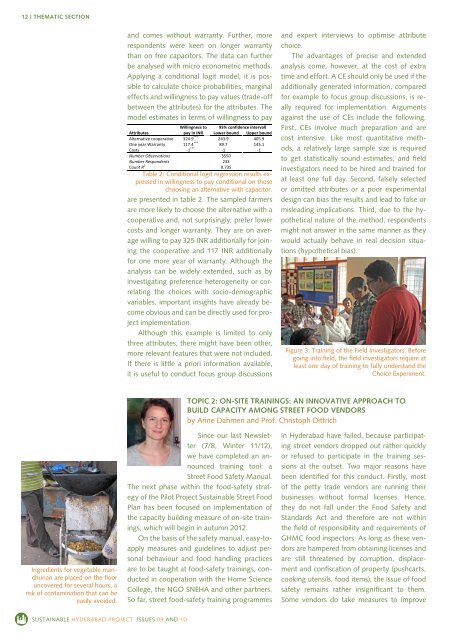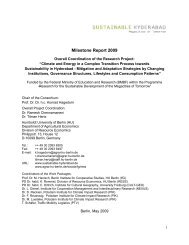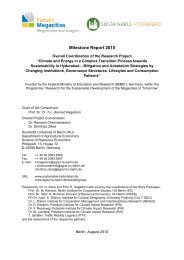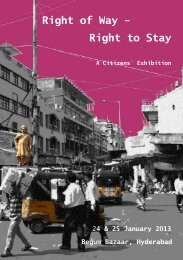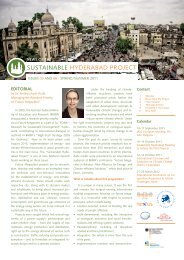SUSTAINABLE HYDERABAD PROJECT
SUSTAINABLE HYDERABAD PROJECT
SUSTAINABLE HYDERABAD PROJECT
Create successful ePaper yourself
Turn your PDF publications into a flip-book with our unique Google optimized e-Paper software.
12 | NEWS THEMATIC FROM SECTION THE <strong>PROJECT</strong> EDITORIAL<br />
and comes without warranty. Further, more<br />
respondents were keen on longer warranty<br />
than on free capacitors. The data can further<br />
be analysed with micro econometric methods.<br />
Applying a conditional logit model, it is possible<br />
to calculate choice probabilities, marginal<br />
effects and willingness to pay values (trade-off<br />
between the attributes) for the attributes. The<br />
model estimates in terms of willingness to pay<br />
Willingness to 95% confidence intervall <br />
Attributes pay in INR Lower bound Upper bound <br />
Alternative cooperative 324.9 *** 243.9 405.9 <br />
One year Warranty 117.4 *** 89.7 145.1 <br />
Costs -‐1 *** -‐1 -‐1 <br />
Number Observations <br />
3550 <br />
Number Respondents <br />
233 <br />
Count R 2 <br />
0.735 <br />
Table 2: Conditional logit regression results expressed in Willingness to pay conditional on <br />
Table 2: Conditional logit regression results expressed<br />
in willingness to pay conditional on those<br />
those choosing an alternative with capacitor <br />
choosing an alternative with capacitor.<br />
are presented in table 2. The sampled farmers<br />
are more likely to choose the alternative with a<br />
cooperative and, not surprisingly, prefer lower<br />
costs and longer warranty. They are on average<br />
willing to pay 325 INR additionally for joining<br />
the cooperative and 117 INR additionally<br />
for one more year of warranty. Although the<br />
analysis can be widely extended, such as by<br />
investigating preference heterogeneity or correlating<br />
the choices with socio-demographic<br />
variables, important insights have already become<br />
obvious and can be directly used for project<br />
implementation.<br />
Although this example is limited to only<br />
three attributes, there might have been other,<br />
more relevant features that were not included.<br />
If there is little a priori information available,<br />
it is useful to conduct focus group discussions<br />
and expert interviews to optimise attribute<br />
choice.<br />
The advantages of precise and extended<br />
analysis come, however, at the cost of extra<br />
time and effort. A CE should only be used if the<br />
additionally generated information, compared<br />
for example to focus group discussions, is really<br />
required for implementation. Arguments<br />
against the use of CEs include the following.<br />
First, CEs involve much preparation and are<br />
cost intensive. Like most quantitative methods,<br />
a relatively large sample size is required<br />
to get statistically sound estimates, and field<br />
investigators need to be hired and trained for<br />
at least one full day. Second, falsely selected<br />
or omitted attributes or a poor experimental<br />
design can bias the results and lead to false or<br />
misleading implications. Third, due to the hypothetical<br />
nature of the method, respondents<br />
might not answer in the same manner as they<br />
would actually behave in real decision situations<br />
(hypothetical bias).<br />
Figure 3: Training of the Field Investigators: Before<br />
going into field, the field investigators require at<br />
least one day of training to fully understand the<br />
Choice Experiment.<br />
TOPIC 2: ON-SITE TRAININGS: AN INNOVATIVE APPROACH TO<br />
BUILD CAPACITY AMONG STREET FOOD VENDORS<br />
by Anne Dahmen and Prof. Christoph Dittrich<br />
Ingredients for vegetable manchurian<br />
are placed on the floor<br />
uncovered for several hours, a<br />
risk of contamination that can be<br />
easily avoided.<br />
Since our last Newsletter<br />
(7/8, Winter 11/12),<br />
we have completed an announced<br />
training tool: a<br />
Street Food Safety Manual.<br />
The next phase within the food-safety strategy<br />
of the Pilot Project Sustainable Street Food<br />
Plan has been focused on implementation of<br />
the capacity building measure of on-site trainings,<br />
which will begin in autumn 2012.<br />
On the basis of the safety manual, easy-toapply<br />
measures and guidelines to adjust personal<br />
behaviour and food handling practices<br />
are to be taught at food-safety trainings, conducted<br />
in cooperation with the Home Science<br />
College, the NGO SNEHA and other partners.<br />
So far, street food-safety training programmes<br />
in Hyderabad have failed, because participating<br />
street vendors dropped out rather quickly<br />
or refused to participate in the training sessions<br />
at the outset. Two major reasons have<br />
been identified for this conduct. Firstly, most<br />
of the petty trade vendors are running their<br />
businesses without formal licenses. Hence,<br />
they do not fall under the Food Safety and<br />
Standards Act and therefore are not within<br />
the field of responsibility and requirements of<br />
GHMC food inspectors. As long as these vendors<br />
are hampered from obtaining licenses and<br />
are still threatened by corruption, displacement<br />
and confiscation of property (pushcarts,<br />
cooking utensils, food items), the issue of food<br />
safety remains rather insignificant to them.<br />
Some vendors do take measures to improve<br />
<strong>SUSTAINABLE</strong> <strong>HYDERABAD</strong> <strong>PROJECT</strong> ISSUES 09 AND 10


